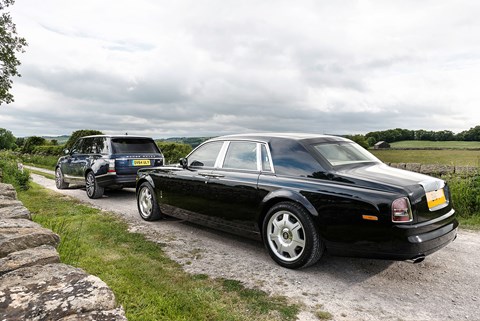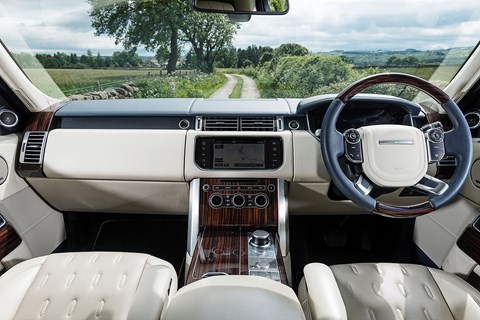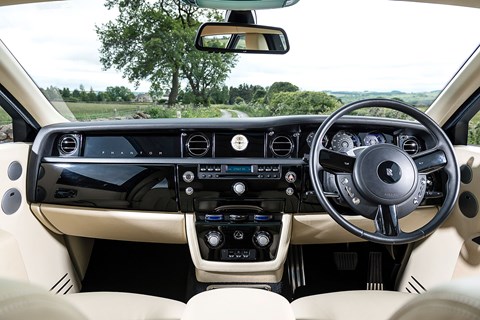► Range Rover vs Rolls Phantom
► New vs used to stretch your budget
► It’s the £140,000 question
Usually when we try to tempt you into buying used limousines at CAR, we look at cars that’ll make you feel like royalty for under £20k. This time we’re setting our sights a little loftier to the Rolls-Royce of limousines. Literally.
When BMW re-launched Rolls-Royce in 2003, the Phantom carried a £250k price tag. The blink-and-you’ll-miss-it changes of the Series II bowed in 2012, helping push early Series I prices well below half that today. But the world has changed since those first new-era Rollers, err, rolled off the Goodwood line, with SUVs increasingly usurping large saloons as the wheels of choice for the very wealthy, and technology bringing new levels of luxury and convenience to the ownership experience.
Take the latest Range Rover. Now offered in long-wheelbase guise, it combines extra legroom and four-seat luxury with go-anywhere capability and stately British design. You can also have a new one for the price of that Rolls-Royce. We’re about to find out if you should.
‘Our’ Rolls-Royce is for sale at GC Motors in Harrogate (gcmotors.co.uk). It’s a 58-plate with 15,000 miles, 21-inch alloys, four-zone climate control, double-glazed glass and soft-close doors; yours for £134,990.
Long-wheelbase Range Rovers start from £104k, but we’ve got the new Range Rover Autobiography Black, which comes no cheaper than in our 4.4 TDV8 spec, for £143k; upgrade to the 5.0-litre supercharged V8 for £3.5k extra if you’re flush.
A decade of expanding vehicle waistlines have nothing on the Rolls: it still feels gargantuan, and you point its prow down byways like you nudge a barge down The Broads; you can only wonder at what the long version must be like to steer. You get into a flow with it, though, that wide, thin-rimmed steering wheel guiding Emily back and forth at the end of the bonnet, the air suspension smothering bumps so ably you wonder if you’d feel a pedestrian beneath the wheels, and the engine so whisperish you can hear every nugget of gravel crunching between tread blocks as you waft to your country house.
The switchgear is wilfully – and likeably – idiosyncratic, with organ stops controlling air vents, buttons hidden in various compartments so as not to be indiscreet, and a sat-nav screen/reversing-camera that revolves out of the dash like 007’s numberplate. The suicide rear doors – handy for those who struggled with the depreciation as the global recession bit – would be a little fiddly to shut, so a butler-button does the job for you, then you can slink into the plush rear bench, back behind granite-like D-pillars and away from curious public gaze. Only the whistle of wind around the A-pillars jars at speed.
Context is an amazing thing, and after the Rolls the Rangie feels wieldy and highly manageable in traffic, the elevated seating position and castellated bonnet making it easy to place. But the V8 diesel is far more vocal, the breathy turbos audible at the exit of every junction, and the ride on this car’s 22-inch rims is far more excitable, with some fractured patter on urban routes and back lanes; the Rolls has a far plusher ride.

Long-wheelbase Rangies get just the two rear seats – the Rolls seats five – and ours has even plusher rear chairs, allowing one rear passenger to motor their seat forward and recline, extending a calf-rest in moments of executive exhaustion. It’s genuinely pleasant, spacious and relaxing, bringing a versatility the Rolls can’t match.
Also out of the Rolls’s league is technology. The Rangie has adaptive cruise control, keyless entry and endless driver-assistance aids, and while the SUV might still be handicapped by tired sat-nav, the Rolls takes us back to the days when an instruction manual was a requirement, not a relic. Cars in this segment showcase new technology, and you notice its absence in the Rolls. Even so, more than a decade on, the Rolls is still the car that makes the biggest statement.
Servicing and running costs
While it uses a unique aluminium spaceframe platform, the Phantom is based on BMW 760i running gear, meaning it adheres to the BMW servicing schedule. Intervals are based on usage or every two years, but GC Motors says the modest miles typically covered by Phantoms means they tend to see them every other year. An oil service involves an oil and filter swap (£405), while an inspection service (£150) has the car up on ramps with all the under-trays removed for a closer look, while pollen filters, air filters and spark plugs (12 of ’em!) may be changed depending on age and mileage at extra cost. You don’t want to be buying a car in need of a major service, ‘a two-day event!’ according to Paul Woodhouse at GC Motors. ‘It can be every third oil change from certain chassis numbers,’ he says. This involves all of the above, plus brake fluid, coolant, air-con service/re-gas, plus software updates, strip-down and re-adjustment of brakes, new wiper blades… You’ll pay around £1800 at GC Motors.
Clearly, you’ll need some cash in reserve, but it’s not always as bad as you might imagine. ‘A lot of the parts come from BMW, and the part numbers you’ll find on the Phantom are the same as the BMW part number,’ says Woodhouse. ‘We had a lower sump seal leak, and Rolls quoted £600, the same part from BMW was £380.’
Both the Range Rover SDV8 and V8 Supercharged models share the same variable service schedule of approximately every 16,000 miles or annually. Marshall Land Rover charges from £445 for the first and third service, from £636 for year two.
Based on a reasonably sensible 40-year-old male, Adrian Flux Insurance quotes £600 with £750 excess for the Rolls, the Range Rover £750 with £750 excess.
Reliability
We spoke to both authorised and independent dealers, but could find no evidence of reliability issues with the Phantom, despite the earliest cars now being 12 years old. Presumably we can attribute this to the quality of Rolls-Royce engineering, the limited mileage these cars typically cover, and that owners are wealthy enough to lavish plenty of maintenance on them.

Many pre-owned Phantoms are sold through Rolls’s Provenance programme, open to any car built at Goodwood since 2003. A Provenance car goes through an extensive pre-sale check-over, where all components – mechanical, bodywork, trim – are guaranteed to be in what Rolls-Royce describes as ‘pinnacle standards’. Any service due within 4000 miles is taken care of, and you’ll also get two years’ free servicing and MoT passes and a minimum two-year warranty with worldwide breakdown cover.
Range Rovers come with a three-year unlimited mileage warranty. VOSA lists a couple of recalls: one for a faulty indicator warning light, another, more critically, for ‘risk of fire’. Make sure a potential purchase has been to the dealer.
Key options
Autobiography Black Range Rovers already carry a huge £40k premium over lesser Autobiographies, so you expect – and get – a high level of standard equipment: Meridian audio, deployable rear tables, top-notch leather and more. To that you can add no-cost panoramic roof and privacy glass, and for the full limousine experience you’ll need rear-seat entertainment (£1500) and Poltrona Frau leather executive rear seats with power-recline functionality (£2500). A jacuzzi is not available, but you can wade to 900mm.
Rolls’s options include a whisky decanter and champagne fridge, theatre seats with rear-seat entertainment, hand-painted coach lines, door cappings inlaid with Mother of Pearl, electrically controlled privacy blinds, crystal glass set, even a humidor for your cigars in the glovebox.

Buy through the Provenance programme and you can add bespoke options to a pre-owned car too. Finally, there’s plenty of room to lounge in the back seats, so forget the long-wheelbase version, which, at over six metres long, is intimidatingly huge.
Verdict
More than a decade since its launch, the Phantom remains the ultimate way to make an entrance, and is hard to distinguish from a new £310k Series II. It’s comfortable, opulent and, mostly, feels crafted to last to the next millennium. A narcoleptic ride and an interior more hushed than an exam hall make it a more relaxing rear-seat experience than the still-plush Range Rover. However, the Rolls is also a clumsy car for UK roads, oozes pre-financial crisis ostentation and lacks the breadth of technology and convenience features now expected at this end of the market.
The Range Rover is more understated, nimble and versatile, has a three-year warranty that’ll help you sleep easy and monsters the Rolls in the increasingly important technology stakes. It’s where we’d feel most comfortable putting our cash.
Rolls vs Range Rover: the numbers
Rolls-Royce Phantom Series I
Price: £134,990 (2008, 15,000 miles)
Engine: 6749cc 48v V12 bi-turbo, 453bhp @ 5350rpm, 531lb ft @ 3500rpm
Transmission: Six-speed auto, rear-wheel drive
Performance: 5.7sec 0-62mph, 149mph, 17mpg, 385g/km CO2
Suspension: Double-wishbone front, multi-link rear; air springs all round
Weight/made from: 2485kg/aluminium
Length/width/height: 5834/2117/1632mm
On sale: 2003-2012
Range Rover Autobiography Black LWB
Price: £143,400
Engine: 4367cc 32v V8 turbodiesel, 334bhp @ 3500rpm, 546lb ft @ 1750rpm
Transmission: Eight-speed auto, 4wd
Performance: 7.2sec 0-62mph, 135mph, 32.5mpg, 229g/km CO2
Suspension: Double-wishbone front, multi-link rear; air springs all round
Weight/made from: 2488kg/aluminium
Length/width/height: 5199/1983/1915
On sale: Now
My rolls-Royce Phantom, Jake Bennett
‘I’ve owned my 2011 Rolls Phantom since February. It has covered 2000 miles and I’ve done half of those. I had a problem with the battery on a journey to London because it had been stood for a long while with its previous owner. Rolls came out within an hour and replaced it. As soon as I got home, they collected the car, fitted a new charging relay and returned it; I can’t fault the aftersales care. The best thing about the car? Every consideration has been made to comfort. I’ve got the rear cinema-type seats, so there’s only space for two, but the comfort is amazing! If I were ordering another, I’d get the star headliner!’
My range Rover, Roger Styles
‘I’ve had Range Rovers before and was considering a long-wheelbase Mercedes S-class, but then the long-wheelbase Range Rover arrived. I’ve got the SDV8 Autobiography, which at £104k was £8k more than the short-wheelbase version. It drives more or less the same, although it’s a little weird as you’re aware of the extra length from the driver’s seat. But rear-seat passengers can really luxuriate with the extra room. Off-road ability is not changed, just a slightly higher ramp break-over angle, but you’d have to be driving over some pretty serious terrain to notice the difference… I never have!’